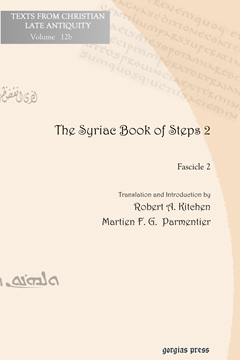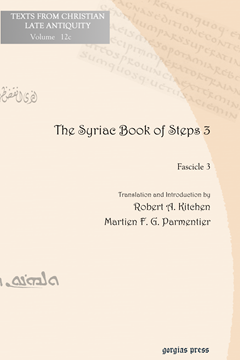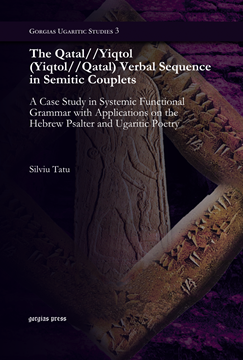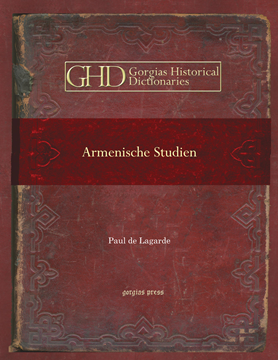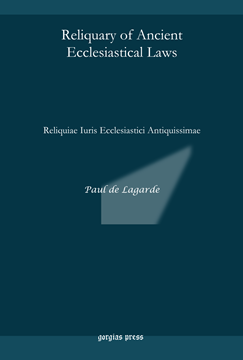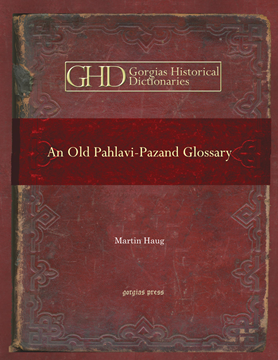The Syriac Book of Steps 2
Syriac Text and English Translation
Translation and Introduction by Robert A. Kitchen & Martien F. G. Parmentier
Series: Texts from Christian Late Antiquity 12b
ISBN: 978-1-59333-980-7
The Syriac Book of Steps collects 30 memre by an anonymous late 4th century author in Persia. It describes the struggle of an actual Christian community, not an idealized one, to live a life in the pursuit of perfection in the midst of a hostile culture. The author details the aspirations and standards of the two ranks of Christians prior to the advent of monasticism: the Upright—married people who work and perform acts of charity—and the Perfect who are celibate, do not work, but live a life of prayer, wandering through the region teaching and mediating conflicts.
$61.00 (USD) $36.60 (USD)
The Syriac Book of Steps 3
Syriac Text and English Translation
Translation and Introduction by Robert A. Kitchen & Martien F. G. Parmentier
Series: Texts from Christian Late Antiquity 12c
ISBN: 978-1-59333-981-4
The Syriac Book of Steps collects 30 sermons by a late 4th century anonymous author in the Persian Empire. The author details the spiritual life, highlighting the duties and problems of two ranks of committed Christians, the Upright and the Perfect.
$67.00 (USD) $40.20 (USD)
The Qatal//Yiqtol (Yiqtol//Qatal) Verbal Sequence in Semitic Couplets
A Case Study in Systemic Functional Grammar with Applications on the Hebrew Psalter and Ugaritic Poetry
By Silviu Tatu
Series: Gorgias Ugaritic Studies 3
ISBN: 978-1-59333-958-6
The book investigates the qatal//yiqtol (yiqtol//qatal) verbal sequence, previously known as ‘tense shifting’, as found in couplets of the Hebrew Psalter, attempting an innovatory explanation by means of M.A.K. Halliday’s Systemic Theory. This study argues that qatal and yiqtol verbal forms, when part of the qatal//yiqtol verbal sequence in Psalms' poetic couplets, can be used primarily for aesthetic reasons, with no individual reference to time or aspect. Arguably, the Systemic Functional Grammar analysis of lexicogrammar can provide a comprehensive interpretation of form and function and an integrated approach to phonetics, morphology and syntax.
$226.00 (USD) $135.60 (USD)
Armenische Studien
Series: Kiraz Historical Dictionaries Archive 14
ISBN: 978-1-59333-986-9
Venturing into the realm of the Armenian language, Lagarde here presents a preliminary glossary of the language. The main body of the book contains over 2400 lexical entries, most of which are brief, dense descriptions of the words. Following the glossary Lagarde provides a comparative chart to the Armenian words including material from Sanskrit, Bactrian or Old Persian, Neo-Persian, Greek, and Semitic. An essay on the history of the study of the language and indices round out this early work on the Armenian tongue. This book, written in German, holds an important place in the study of Armenian.
$138.00 (USD) $82.80 (USD)
Reliquary of Ancient Ecclesiastical Laws
Reliquiae Iuris Ecclesiastici Antiquissimae
ISBN: 978-1-59333-988-3
A notable resource for both church historians and linguists, this work of Lagarde contains both Syriac and Greek materials concerning ancient ecclesiastical laws. A number of ancient documents are cited in this unusual collection. Half of this collection is presented in the original Syriac and half in the original Greek. All introductions and notes are written in Latin. Intended for the serious linguist and church historian, this work requires language skills to unravel. As a collection of materials that had been inaccessible up to Lagarde’s time, this volume also serves as a period piece containing a fresh view of writings that helped inform the growth of canon law.
$159.00 (USD) $95.40 (USD)
An Old Pahlavi-Pazand Glossary
Edited with an Alphabetical Index
By Martin Haug
Series: Kiraz Historical Dictionaries Archive 15
ISBN: 978-1-59333-995-1
Originally compiled by Destur Hoshangji Jamaspji Asa, this historic dictionary was revised and enlarged by Martin Haug. This edition of the glossary represents the first time that the Pahlavî-Pâzand, or Saanian Farhang, was published in its ancient form and arrangement. The dictionary is of an Aramaic translation into Middle Persian, in Pahlavi script. A substantial introductory essay on Pahlavi begins the work; entries are translated into English, occasionally reaching substantial essays. A truly historic attempt to document a language far removed from many European and new world scholars, Haug has produced an indispensable historic dictionary.
$191.00 (USD) $114.60 (USD)
